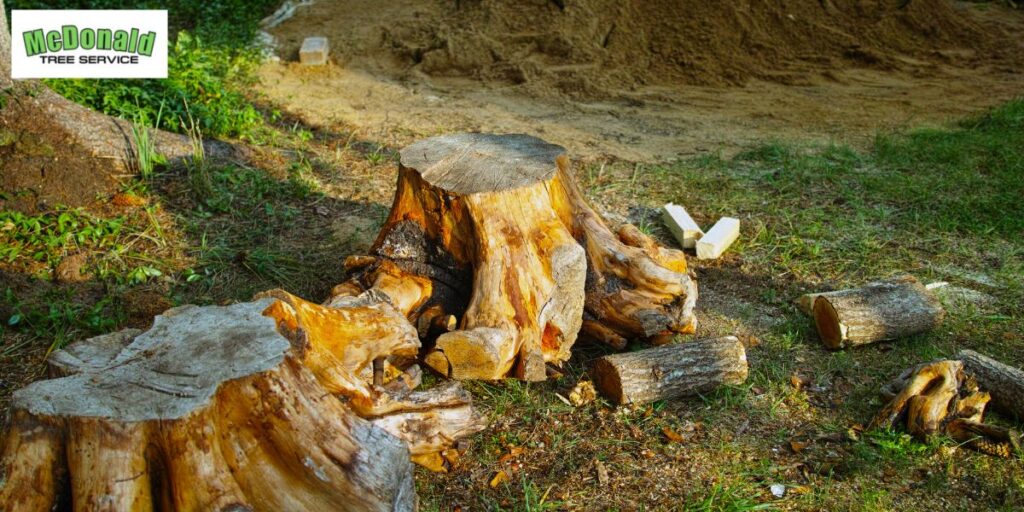Imagine the quiet aftermath of a heavy downpour or a winter snowstorm. At first glance, everything seems peaceful—but beneath that temporary calm lie dangers: weakened trees, slick branches, and soggy ground that spell trouble for your home and property. After severe weather, many homeowners face pressing questions: Is that leaning tree safe? Does the old stump left behind become a hazard when hidden in snow? That’s when tree removal and stump grinding emerge not just as services, but as vital safeguards.
In this blog, we’ll guide you through what to expect after heavy rain or snowfall: the hazards to look out for, the removal process, why stump grinding is so important, and how local experts—like McDonald Tree Service in Billerica, MA—can deliver safe, reliable solutions across communities such as Woburn, Bedford, Burlington, Lowell, and Chelmsford.
How Heavy Rain and Snow Affect Trees
Storms bring two main challenges:
- Soil saturation: Prolonged rain softens the soil, weakening a tree’s anchor. Even gentle winds can topple what once seemed stable.
- Excessive weight: Snow and ice accumulation can overload branches and branches, increasing the chance of breakage or splitting.
These weather events often result in:
- Uprooted or partially uprooted trees.
- Snapped limbs hanging precariously.
- Leaning trunks that lean further with the next gust.
Worsening this, wet or snowy ground complicates removal: it’s slippery, less stable under equipment, and demands special precautions.
When to Call a Professional for Tree Removal and Stump Grinding
Know when to call for help:
- A tree is splitting, leaning alarmingly, or visibly stressed after a storm.
- Roots are exposed or rising from saturated soil.
- Stumps or debris are hidden—and pose tripping or equipment hazards—especially under snow.
Delays can lead to personal injuries or disastrous property damage. That’s where a professional tree service stump grinding crew comes in to restore safety and peace of mind swiftly.
The Tree Removal Process After Severe Weather
Here’s what typically happens:
- Safety assessment: Professionals evaluate how the weather has impacted trees, nearby structures, and site access.
- Securing the site: They protect the surrounding area and ensure safe zones are established.
- Specialized equipment deployment: Tools like cranes, bucket trucks, or heavy-duty chainsaws navigate the soggy, uneven terrain.
- Weather-aware removal: Crews adapt methods depending on conditions—wet versus icy terrain requires different handling.
In places like Billerica, Lowell, or Chelmsford, where backyards and driveways may be constrained or sloped, this level of expertise is critical.
Why Stump Grinding Is Essential After Storm Damage

Removing tree stumps may be tempting to skip—but here’s why stump grinding should never be overlooked:
- Eliminates tripping and safety hazards, critical when snow or mud obscures ground level.
- Prevents pest infestations: Stumps attract termites, ants, and fungi, which can spread to healthy plants.
- Stops unwanted regrowth: Grinding disrupts the stump’s root system, reducing the chance of new shoots.
- Revives your landscape: It transforms unsightly remnants into a clean canvas for grass or new planting.
- Is fast, efficient, and less invasive than full stump removal—it respects the existing yard while delivering results quickly.
Moreover, professional stump grinding ensures underground utilities are identified, preventing dangerous accidents during operation.
Location-Based Considerations
Storm recovery needs vary by community:
- Billerica & Burlington, MA: Suburban neighborhoods with driveways and play areas—stump grinding after storms prevents hidden hazards under snow.
- Woburn & Lowell, MA: Urban properties may struggle with stormwater pooling; removing stumps aids proper drainage and keeps walkways safe.
- Chelmsford & Bedford, MA: Larger lawns and wooded slopes benefit from clean stumps to prep for replanting, outdoor recreation, or simply to regain lost yard space.
In each of these areas, choosing a local expert for tree removal stump grinding—one familiar with winter challenges and terrain—is key to a smooth, safe recovery.
Seasonal Prevention Tips
Flatten future risks with these simple steps:
- Autumn pruning: Remove weak or dead branches before winter stress.
- Fall and early spring tree inspections: Catch rot, disease, or loose limbs before they become emergencies.
- Improve drainage: Grade yard surfaces to direct water away from roots.
- Lift stumps early: If a storm’s forecast is coming, get lingering stumps eliminated ahead of time.
Proactive maintenance cuts emergency needs—and helps you avoid the added cost and hassle after a storm.
Why Choose a Local Expert Like McDonald Tree
Homeowners across Middlesex County trust McDonald Tree Service for fast, dependable tree removal and stump grinding:
- Extensive experience: Over 20 years serving local residents and businesses .
- Emergency readiness: Offers 24/7 storm damage response, pruning, crane use, stump grinding, and land clearing.
- Strong reviews: Customers praise their professionalism, responsiveness, and thorough cleanup.
- Local understanding: Familiar with MA terrain, drainage challenges, and winter weather nuances.
When heavy rain or snowfall hits, they’re well-equipped to clear hazards and restore your yard with confidence.
Conclusion
Heavy rain and snow can leave behind more than just soggy lawns—they can destabilize trees, hide dangerous stumps under snow, and make landscapes unsafe. Swift action through tree removal and stump grinding is not merely cosmetic—it’s vital for safety, aesthetics, and long-term yard health.
For homeowners in communities like Billerica, Woburn, Burlington, Lowell, Bedford, and Chelmsford, partnering with a trusted local service ensures your property is restored quickly and responsibly. If you’re facing storm damage, don’t wait—reach out to a professional who understands both the terrain and the weather: McDonald Tree Service stands ready to help.
FAQs
Is stump grinding safe during or immediately after a storm?
Stumps should only be addressed once conditions stabilize. Wet and icy ground increases risk—professionals ensure safe access, evaluate soil stability, and avoid hazards like buried utilities.
How deep does stump grinding go?
Stumps are typically ground 6 to 12 inches below ground—deep enough to deter regrowth and level the surface for grass or landscaping.
Can I plant a new tree where a storm-damaged stump was ground?
Yes—once ground, the area can be replanted. It’s advised to remove woodchips and let the soil settle to avoid planting issues.
What happens to the wood chips after stump grinding?
Chips can be reused as mulch or compost if the tree wasn’t diseased. If disease was present, chips must be properly disposed of to prevent spread.
Why is stump grinding preferable to full stump removal?
Grinding is quicker, gentler on surrounding landscaping, more affordable, and creates useful mulch—making it a smart choice for storm-impacted yards.



